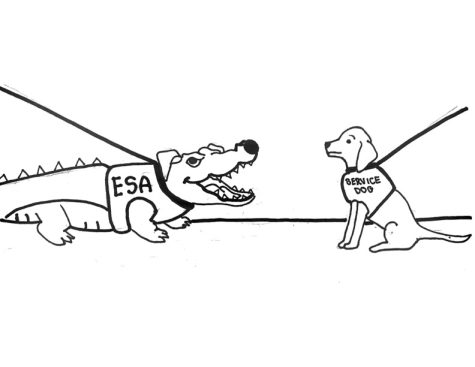A canine quandary: Shedding light on the difference between service and emotional support animals
March 4, 2023
A shaggy, long-necked alpaca strolls through a museum, ready to knock down delicate glass figurines, porcelain vases and ceramic sculptures with a forceful hind leg kick. Bystanders are no longer focusing on the antique paintings, but instead wondering whether the animal will spit on a priceless piece of art — or worse, an unsuspecting museum visitor. But the main question circling people’s minds is: How did this farm animal get into a museum in the first place?
 This chaos became a reality when a New Yorker Magazine writer posed a variety of animals as emotional support animals (ESA) to test which public areas they would be permitted to enter. The experiment highlights the growing misconceptions regarding the difference between ESAs and service dogs and the resulting disruption and danger that can occur. It is vital that there is a proper screening process for ESAs so that their lack of training does not disrupt ESAs and service dogs who have gone through the appropriate training.
This chaos became a reality when a New Yorker Magazine writer posed a variety of animals as emotional support animals (ESA) to test which public areas they would be permitted to enter. The experiment highlights the growing misconceptions regarding the difference between ESAs and service dogs and the resulting disruption and danger that can occur. It is vital that there is a proper screening process for ESAs so that their lack of training does not disrupt ESAs and service dogs who have gone through the appropriate training.
Similar to psychiatrists and psychologists, who are often grouped together despite their different roles and required medical training, the vast difference between service dogs and ESAs is also overlooked. Service dogs undergo rigorous two-year training in order to pass a qualifying exam, while the only requirement for ESAs is a letter from a medical professional proving that the owner has a medical condition.
Many online ESA certification sites, like National Service Animal Registry, distribute certifications without in-person meetings or conversations with mental health providers. This practice leads many animals to be granted the title of an ESA, regardless of a lack of certification or proper training. The National Service Animal Registry further sheds light on the massive increase in ESAs, reporting that in 2014 they had certified more than 65,000 animals, and by 2018 that number doubled.
Due to a faulty ESA screening process, service dogs encounter frequent attacks by ESAs that lack training despite certification, further highlighting the need for a stricter certification process. Kim Wilson, a woman from New Mexico, has owned three service dogs from Canine Companions for Independence (CCI) and was interviewed by the Associated Press. She was shocked when one of her dogs was chased through two isles and attacked in a store by an ESA.
“I spoke with management and explained that this little faker [the ESA] went after a service dog that cost about $50,000 to raise, train and socialize,” Wilson said.
Unfortunately, Wilson’s dog was not the only CCI graduate that had an encounter with an aggressive ESA. 77 percent of CCI service dogs have had an aggressive confrontation with an animal. Meanwhile, a quarter of the CCI service dogs had more than 10 encounters with a misbehaving animal, while more than half of the CCI service dogs were either bitten, barked or nipped at.
Experiences with fake or misbehaving ESAs lead many businesses to deny service dogs entry even though they are allowed access to all public areas. In an article written for The Guardian, Ryan Honick explained his frustration when people mistake his dog Pico, a service labrador who helps him with his daily tasks, for an ESA, who does not go through as much rigorous training as service dogs.
“People’s perceptions get skewed because somebody brought in their misrepresented animal. And that makes it harder for people like me, who have a legitimately trained dog who’s never caused any problems, because there’s this wariness,” Honick said.
Nevertheless, the importance of ESAs in their ability to assist those who struggle with mental health cannot be understated. In fact, many will argue that similar to a service dog, ESAs should be allowed in public places to help their owner overcome anxiety and other mental afflictions. However, despite ESAs’ necessity, it’s important to first implement more rigorous screening methods to certify them, in order to ensure the safety of service dogs and their owners.
Undoubtedly, service animals and ESAs play an essential role in the lives of many, especially at Redwood, where there are assistance dogs to help students with their feelings of anxiety and stress. We need to recognize the benefits that ESAs and service dogs provide as well understand the importance of proper training and certification so correctly trained ESAs and service dogs can effectively support their owners without distraction.





















